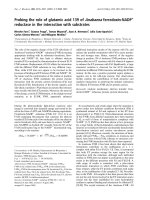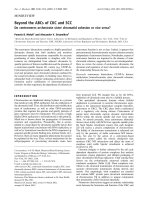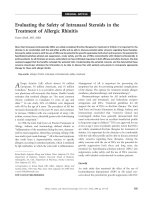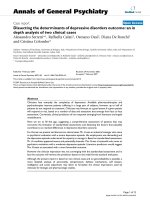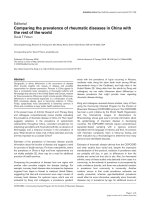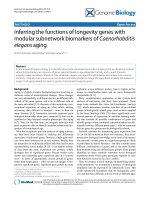Báo cáo y học: "Uncovering the complexities of Kaposi’s sarcoma through genomewide expression analysis" pdf
Bạn đang xem bản rút gọn của tài liệu. Xem và tải ngay bản đầy đủ của tài liệu tại đây (74.73 KB, 4 trang )
Genome Biology 2004, 5:247
comment
reviews
reports deposited research
interactions
information
refereed research
Minireview
Uncovering the complexities of Kaposi’s sarcoma through genome-
wide expression analysis
Daniel Di Bartolo and Ethel Cesarman
Address: Weill Medical College of Cornell University, New York, NY 10021, USA.
Correspondence: Ethel Cesarman. E-mail:
Abstract
Gene-expression profiling of endothelial cells infected with Kaposi’s sarcoma-associated
herpesvirus has led to a greater understanding of the histogenesis of Kaposi’s sarcoma and the
cellular reprogramming events that occur as a result of viral infection and that may play important
roles in viral pathogenesis.
Published: 1 November 2004
Genome Biology 2004, 5:247
The electronic version of this article is the complete one and can be
found online at />© 2004 BioMed Central Ltd
Kaposi’s sarcoma (KS) is a peculiar neoplasm that has a
diverse cellular makeup and an extensive neovasculature.
Because of the complexity of this vascular proliferative dis-
order there are several questions that remain unanswered.
Recently, several groups have used gene-expression
microarrays in an effort to better understand the nature and
pathogenesis of KS [1-5]. KS was first identified in 1872 by
Moritz Kaposi, a Hungarian dermatologist who described it
as an “idiopathic multiple pigmented sarcoma of the skin”,
which was lethal in his patients [6]. This ‘classical’ form of
KS was further described as a rare, indolent disease predom-
inantly found in older men of Mediterranean and Eastern
European descent. In the 1950s, ‘endemic’ KS, a more
aggressive form of KS, was identified in parts of sub-Saharan
Africa. Shortly thereafter, an ‘iatrogenic’ form of KS was
diagnosed in immunosuppressed organ-transplant patients.
A fourth form of KS, ‘epidemic’ KS, was identified in the
1980s, initially in homosexual men with acquired immune
deficiency syndrome (AIDS). The epidemiology of KS - in
particular its geographical distribution as well as its preva-
lence in gay men - suggested that there was an infectious eti-
ological agent for this disease. In 1994, a novel human
␥-herpesvirus, Kaposi’s sarcoma-associated herpesvirus
(KSHV), also known as human herpesvirus 8 (HHV8), was
identified through representational difference analysis
whereby KS tissue was compared with normal tissue from
the same individual [7]. KSHV is invariably found in the
spindle-shaped cells present in all KS tumors.
Histogenesis of KS
The histopathology of KS is similar for all four clinical forms of
KS and three stages have been identified in the progression of
the lesion. Early on, in the ‘patch’ stage, thin-walled vascular
spaces are visible in the upper dermis with a sparse mononu-
clear cell infiltrate of lymphocytes, plasma cells and
macrophages. In the ‘plaque’ stage, these vascular spaces
increase in number and spindle-cell bundles accumulate
around them. In the late ‘nodular’ stage, the tumor is more
solid and consists of large fascicles of spindle-shaped cells with
fewer and more compact vascular slits. The mononuclear cell
infiltrate is no longer prominent and few extravasated erythro-
cytes and macrophages are present between spindle cells.
Controversy has surrounded the cellular origin and nature of
KS. Some studies have shown that KS spindle cells express
markers characteristic of endothelial cells [8-10]. Other
researchers have argued that they may be comprised of a
more heterogeneous population that includes dendritic cells,
macrophages, smooth muscle cells, cells from lymphatic junc-
tions or fibroblasts [11-13]. Similarly, there has been much
discussion over whether KS represents a clonal neoplasm or
a hyperproliferative reactive response. Support for the latter
comes from studies which show that cultured KS cells are
dependent on exogenous growth factors and do not produce
tumors when transplanted into nude mice but rather induce
an inflammatory and angiogenic response [14]. The lack of
identifiable chromosomal abnormalities and the occasional
regression of KS spontaneously or upon restoration of
immune function [15] all contribute to the notion that KS is a
result of an inflammatory response. On the other hand, KS
lesions have been found to be monoclonal in a subset of
advanced cases [16], and three cell lines with chromosomal
alterations have been successfully established from KS
lesions, suggesting that at least some advanced cases are
neoplastic [17,18]. A current model is that KS develops from
a proliferative inflammatory response that later, under
certain selective pressures and/or as a result of cellular
genetic alterations, gives rise to a neoplastic monoclonal
lesion [19].
Recent studies have suggested that KS spindle cells are
derived from lymphatic endothelial cells (LECs) rather than
blood vascular endothelial cells (BECs) on the basis of their
expression of vascular endothelial growth factor receptor-3
(VEGFR-3), a marker of lymphatic endothelium [8,10].
VEGFR-3, however, can also be expressed by precursor
endothelial cells, so the precise histogenesis of KS lesions has
not been definitively clarified. Recently, Wang et al. [1] have
weighed in on this issue in a report in the July 2004 issue of
Nature Genetics. In this elegant study [1], oligonucleotide
microarray analysis was performed on nodular KS biopsy
samples in comparison with several normal tissue types. The
nodular KS lesions used in this study were composed of over
80% spindle cells, thus minimizing dermal and epidermal
contaminants. The expression profile of KS lesions most
closely resembled endothelial cells on a multidimensional
scaling (MDS) plot. Furthermore, the KS gene-expression
‘signature’ was examined for the expression of 114 genes that
had previously been found to differentiate LECs from BECs,
and the authors found that KS spindle cells were more
closely related to LECs. KS cells may not represent a pure
population of LECs, however, as their expression signature
contained some markers for BECs as well.
To examine whether KSHV alters the transcriptional
program in KS spindle cells and thereby produces an inde-
terminate endothelial cell phenotype, Wang et al. [1]
infected both LECs and BECs with KSHV and compared
their expression profiles to those of uninfected counterparts.
They found that the genetic profiles of both KSHV-infected
endothelial cell populations differed from those of the unin-
fected populations. Moreover, upon KSHV infection, the
transcriptional program of these two populations became
more similar to each other (Figure 1). These findings suggest
two possibilities: that KS lesions are composed of both
infected LEC and BEC populations, or, alternatively, that
KSHV infects precursor endothelial cells and drives them to
become more LEC-like.
Pathogenesis of KS
Other groups have used in vitro systems in which endothelial
cells have been infected with KSHV [20-23]. These methods
provide a relevant model of KS as they share some characteris-
tics with KS lesions. Upon infection, endothelial cells change
from a cobblestone appearance to the elongated, spindle-
shaped morphology seen in KS lesions. Like KS spindle cells,
most infected endothelial cells express latency-associated
nuclear antigen (LANA), indicative of KSHV latency, whereas a
smaller percentage stain positively for lytic-cycle proteins.
Flore et al. [20] found that infection of endothelial cells
resulted in upregulation of telomerase and long-term survival.
Moreover, the infected cells, which represented only 1-6% of
the population in this system, provided a proliferative advan-
tage to uninfected cells in the culture, possibly through a
paracrine mechanism involving the upregulation of kinase-
insert domain receptor (KDR), a VEGF receptor. Other investi-
gators have developed more robust in vitro infection models,
using normal or immortalized endothelial cells [21-23].
Recently, microarrays have been used along with these in vitro
systems to gain a more comprehensive picture of early cellular
events and signaling pathways that are affected by KSHV infec-
tion and that may play a role in the pathogenesis of KS. This
approach allows a direct comparison between endothelial cells
infected with KSHV and matched uninfected cells, and study of
the early events that follow infection, the latter being impossi-
ble with KS biopsies.
247.2 Genome Biology 2004, Volume 5, Issue 11, Article 247 Di Bartolo and Cesarman />Genome Biology 2004, 5:247
Figure 1
Infection of blood vascular endothelial cells and lymphatic endothelial cells
with KSHV. The study by Wang et al. [1] found that the infected cells have a
transcription profile that lies between those of the two starting cell types but
is closer to that of lymphatic endothelium. In most cells the virus establishes
a latent infection, whereas a small proportion develop a lytic infection.
KSHV
Blood vascular
endothelial cell
Lymphatic
endothelial cell
Lytic infection
Host transcription shut off
Expression of lytic genes that
induce paracrine angiogenesis
Latent infection
Transcriptional reprogramming
Mixed phenotype
Gene-expression profiling by four separate groups has uncov-
ered complex transcriptional remodeling that takes place in
endothelial cells as a result of KSHV infection (Table 1) [2-5].
Using a model of lytic infection, Glaunsinger and Ganem [24]
showed that cellular gene expression is dramatically inhibited
by KSHV via a mechanism that involves acceleration of global
mRNA turnover. To identify whether any host genes are
capable of escaping this shutoff, in a separate study the same
authors used microarray analysis on telomerase-immortalized
microvascular endothelial (TIME) cells infected with KSHV,
and subsequently lytically reactivated the virus by ectopic
expression of its replication and transcriptional activator
(RTA) [2]. They identified a subset of genes that were upregu-
lated despite KSHV-mediated shutoff. A KSHV lytic gene
product thought to be critical for KS development, vGPCR, has
been shown to activate a number of signaling pathways, such
as phosphatidylinositol 3´-kinase (PI3K), c-Jun N-amino
terminal kinase (JNK) and p38, and to induce expression of
multiple genes [25-27]. Interestingly, the expression of many
of the host genes that are upregulated by vGPCR is blocked in
KSHV-infected TIME cells. These data suggest that host gene
expression is dictated by a complex interplay of viral genes
that cannot be fully understood by examining the effects of a
single viral gene product.
Others studies have evaluated the effect of KSHV infection in
largely latently infected endothelial cells. Poole et al. [3]
infected primary dermal microvascular endothelial cells
(DMVECs) and looked at changes in their gene expression
after 3 and 5 weeks. Moses et al. [4] used a method of infecting
DMVECs that had previously been immortalized with the E6
and E7 genes of human papillomavirus (HPV); their analysis
was done 4 weeks after KSHV infection. Another group was
interested in evaluating changes in host gene expression
during acute infection: Naranatt et al. [5] infected primary
DMVECs and looked at host-cell transcriptional reprogram-
ming 2 and 4 hours after KSHV infection. Together, the data
from these four studies [2-5] reveal the ability of KSHV to
modify the expression of genes involved in immune defense
and inflammation, apoptosis, remodeling of the extracellular
matrix, processing and stability of proteins, angiogenesis,
and regulation of the cell cycle. Comparison of the data
reveals about a dozen genes (IRF7, Mx1, IFN-induced trans-
membrane protein, guanylate binding protein 1, Mx R2, SSI-
3, vEts transcription factor, tissue plasminogen activator,
IL-8, Bcl-3, nucleoside phosphorylase, and tissue inhibitor
of metalloproteinase-1) that were upregulated in both the
Poole et al. [3] and Naranatt et al. [5] studies, and seven
genes (RDC-1, LIM domain only 2, MADS box transciption
factor, galactoside binding lectin, gap junction protein ␣1,
interleukin 1 receptor type 1, and CC-chemokine 14) upregu-
lated and three downregulated (stromal cell derived factor 1,
urokinase plasminogen activator, and thioredoxin reductase
1) in both the Poole et al. [3] and the Moses et al. [4] studies.
The available gene-expression data on KSHV-infected
endothelial cells provide interesting insights into the
molecules that may play an important role in KS tumor
progression, validate previously established players and
offer new potential targets for treatment. Moses et al. [4]
found c-Kit, a receptor tyrosine kinase for the mast cell
growth factor SCF, to be upregulated in their assays. Upon
comment
reviews
reports deposited research
interactions
information
refereed research
Genome Biology 2004, Volume 5, Issue 11, Article 247 Di Bartolo and Cesarman 247.3
Genome Biology 2004, 5:247
Table 1
Summary of the recent microarray studies of Kaposi’s sarcoma (KS)
Study Cells used Time analyzed (post-infection) Access to database Major findings
Wang et al. [1] Primary LECs and BECs 2 and 7 days ArrayExpress [29] Expression profile of KS lesions closely
Accession number: E-MEXP-66 resembles that of endothelial cells; infection
of BECs and LECs results in an intermediate
gene-expression profile
Glaunsinger and TIME cells (induced 6, 12 and 20 h Gene Expression Omnibus [30] Widespread shutoff of host genes during
Ganem [2] lytic replication 2 h Accession number: GSE1406 KSHV lytic replication; a subset of genes
post-KSHV infection) resistant to shutoff are upregulated during
lytic reactivation
Naranatt et al. [5] Primary DMVECs 2 and 4 h Contact Dr Bala Chandran 215 genes upregulated; 109 genes
(University of Kansas Medical downregulated
Center, Kansas City USA)
Poole et al. [3] Primary DMVECs 3 and 5 weeks Pevsner lab website [31] Around 2% of genes upregulated and 2%
downregulated
Moses et al. [4] DMVECs previously 4 weeks Früh lab website [32] 124 genes upregulated; 60 genes
immortalized with downregulated
HPV proteins
E6 and E7
LEC, lymphatic endothelial cells; BEC, blood vascular endothelial cells; TIME, telomerase-immortalized microvascular endothelial; KSHV, Kaposi’s
sarcoma-associated herpesvirus; DMVEC, dermal microvascular endothelial cells; HPV, human papillomavirus.
further investigation, they found that c-Kit is involved in the
transformed phenotype of DMVECs infected with KSHV and
that it provides the cells with a proliferative advantage in
response to exogenous SCF. As a result of these studies, clin-
ical trials are ongoing to evaluate the effect of inhibiting c-
Kit with Gleevec (Imatinib) in the treatment of KS. KDR,
which was previously reported to be upregulated by KSHV
[20] and provides a proliferative advantage to infected
endothelial cells [28], was also found to be upregulated [4].
CD36, a receptor that binds to, among other things, the
angiogenesis inhibitor thrombospondin-1 (TSP-1), is highly
induced as a result of KSHV infection [4]. TSP-1 is a potent
inhibitor of angiogenesis and effectively inhibits a wide
variety of angiogenic stimuli, including VEGF. Treatment
with exogenous TSP-1 may, therefore, be an effective way of
limiting the vascularization of KS lesions.
Direct comparison between the microarrays used in the
various recent studies is complicated by the small overlap of
genes represented on the different arrays. Also, differences in
the systems of KSHV infection and in the time after infection
that the arrays were performed contribute to variability
between the assays. Nevertheless, each of these studies pro-
vides us with a greater understanding of the complex nature of
transcriptional reprogramming that takes place at the hands of
KSHV during the infection process and how changes induced
by KSHV lead to angiogenic lesions characteristic of KS.
References
1. Wang H-W, Trotter MWB, Lagos D, Bourboulia D, Henderson S,
Mäkinen T, Elliman S, Flanagan AM, Alitalo K, Boshoff C: Kaposi
sarcoma herpesvirus-induced cellular reprogramming con-
tributes to the lymphatic endothelial gene expression
profile of Kaposi sarcoma. Nat Genet 2004, 36:687-693.
2. Glaunsinger B, Ganem D: Highly selective escape from KSHV-
mediated host mRNA shutoff and its implications for viral
pathogenesis. J Exp Med 2004, 200:391-398.
3. Poole LJ, Yu Y, Kim PS, Zheng QZ, Pevsner J, Hayward GS: Altered
patterns of cellular gene expression in dermal microvascu-
lar endothelial cells infected with Kaposi’s sarcoma-associ-
ated herpesvirus. J Virol 2002, 76:3395-3420.
4. Moses AV, Jarvis MA, Raggo C, Bell YC, Ruhl R, Luukkonen BG, Grif-
fith DJ, Wait CL, Druker BJ, Heinrich MC, et al.: Kaposi’s
sarcoma-associated herpesvirus-induced up-regulation of
the c-kit proto-oncogene, as identified by gene expression
profiling, is essential for the transformation of endothelial
cells. J Virol 2002, 76:8383-8399.
5. Naranatt PP, Krishman HH, Svojanovsky SR, Bloomer C, Mathur S,
Chandran B: Host gene induction and transcriptional repro-
gramming in Kaposi’s sarcoma associated herpesvirus
(KSHV/HHV-8)-infected endothelial, fibroblast, and B cells:
insights into modulation events early during infection. Cancer
Res 2004, 64:72-84.
6. Kaposi M: Idiopathisches multiples Pigmentsarkom der Haut.
Arch Dermatol Syphilol 1872, 4:265-278.
7. Chang Y, Cesarman E, Pessin MS, Lee F, Culpepper J, Knowles DM,
Moore PS: Identification of herpesvirus-like DNA sequences in
AIDS-associated Kaposi’s sarcoma. Science 1994, 266:1865-1869.
8. Kahn HJ, Bailey D, Marks A: Monoclonal antibody D2-40, a new
marker of lymphatic endothelium, reacts with Kaposi’s
sarcoma and a subset of angiosarcomas. Mod Pathol 2002,
15:434-440.
9. Uccini S, Ruco LP, Monardo F, Stoppacciaro A, Dejana E, La Parola
IL, Cerimele D, Baroni CD: Coexpression of endothelial cell
and macrophage antigens in Kaposi’s sarcoma cells. J Pathol
1994, 173:23-31.
10. Dupin N, Fisher C, Kellam P, Ariad S, Tulliez M, Franck N, van Marck
E, Salmon D, Gorin I, Escande JP, et al.: Distribution of human
herpesvirus-8 latently infected cells in Kaposi’s sarcoma,
multicentric Castleman’s disease, and primary effusion lym-
phoma. Proc Natl Acad Sci USA 1999, 96:4546-4551.
11. Regezi JA, MacPhail LA, Daniels TE, DeSouza YG, Greenspan JS,
Greenspan D: Human immunodeficiency virus-associated oral
Kaposi’s sarcoma. A heterogeneous cell population domi-
nated by spindle-shaped endothelial cells. Am J Pathol 1993,
143:240-249.
12. Kaaya EE, Parravicini C, Ordonez C, Gendelman R, Berti E, Gallo
RC, Biberfeld P: Heterogeneity of spindle cells in Kaposi’s
sarcoma: comparison of cells in lesions and in culture. J
Acquir Immune Defic Syndr Hum Retrovirol 1995, 10:295-305.
13. Gallo RC: The enigmas of Kaposi’s sarcoma. Science 1998,
282:1837-1839.
14. Salahuddin SZ, Nakamura S, Biberfeld P, Kaplan MH, Markham PD,
Larsson L, Gallo RC: Angiogenic properties of Kaposi’s
sarcoma-derived cells after long-term culture in vitro. Science
1988, 242:430-433.
15. Aboulatia DM: Regression of acquired immunodeficiency syn-
drome-related pulmonary Kaposi’s sarcoma after highly
active retroviral therapy. Mayo Clin Proc 1998, 73:439-43.
16. Gill PS, Tsai YC, Rao AP, Spruck CH 3rd, Zheng T, Harrington WA
Jr, Cheung T, Nathwani B, Jones PA: Evidence for multiclonality
in multicentric Kaposi’s sarcoma. Proc Natl Acad Sci USA 1998,
95:8257-61.
17. Lunardi-Iskandar Y, Bryant JL, Zeman RA, Lam VH, Samaniego F,
Besnier JM, Hermans P, Thierry AR, Gill P, Gallo RC: Tumorigene-
sis and metastasis of neoplastic Kaposi’s sarcoma cell line in
immunodeficient mice blocked by a human pregnancy
hormone. Nature 1995, 375:64-68.
18. Benelli R, Albini A, Parravicini C, Carlone S, Repetto L, Tambussi G,
Lazzarin A: Isolation of spindle-shaped cell populations from
primary cultures of Kaposi’s sarcoma of different stage.
Cancer Lett 1996, 100:125-32.
19. Bubman D, Cesarman E: Pathogenesis of Kaposi’s sarcoma.
Hematol Oncol Clin North Am 2003, 17:717-745.
20. Flore O, Rafii S, Ely S, O’Leary JJ, Hyjek EM, Cesarman E: Transfor-
mation of primary human endothelial cells by Kaposi’s
sarcoma-associated herpesvirus. Nature 1998, 394:588-592.
21. Ciufo DM, Cannon JS, Poole LJ, Wu FY, Murray P, Ambinder RF,
Hayward GS: Spindle cell conversion by Kaposi’s sarcoma-
associated herpesvirus: formation of colonies and plaques
with mixed lytic and latent gene expression in infected
primary dermal microvascular endothelial cell cultures. J
Virol 2001, 75:5614-5626.
22. Moses AV, Fish KN, Ruhl R, Smith PP, Strussenberg JG, Zhu L, Chan-
dran B, Nelson JA: Long-term infection and transformation of
dermal microvascular endothelial cells by human her-
pesvirus 8. J Virol 1999, 73:6892-6902.
23. Lagunoff M, Bechtel J, Venetsanakos E, Roy AM, Abbey N, Herndier
B, McMahon M, Ganem D: De novo infection and serial trans-
mission of Kaposi’s sarcoma-associated herpesvirus in cul-
tured endothelial cells. J Virol 2002, 76:2440-2448.
24. Glaunsinger B, Ganem D: Lytic KSHV infection inhibits host
gene expression by accelerating global mRNA turnover. Mol
Cell 2004, 13:713-723.
25. Arvanitakis L, Geras-Raaka E, Varma A, Gershengorn MC, Cesarman
E: Human herpesvirus KSHV encodes a constitutively active
G-protein-coupled receptor linked to cell proliferation.
Nature 1997, 385:347-350.
26. Bais C, Santomasso B, Coso O, Arvanitakis L, Raaka EG, Gutkind JS,
Asch AS, Cesarman E, Mesri EA, Gershengorn MC: G-protein-
coupled receptor of Kaposi’s sarcoma-associated her-
pesvirus is a viral oncogene and angiogenesis activator.
Nature 1998, 391:86-89.
27. Smit MJ, Verzijl D, Casarosa P, Navis M, Timmerman H, Leurs R:
Kaposi’s sarcoma-associated herpesvirus-encoded G
protein-coupled receptor ORF74 constitutively activates
p44/p42 MAPK and Akt via G(i) and phospholipase C-depen-
dent signaling pathways. J Virol 2002, 76:1744-1752.
28. Masood R, Cesarman E, Smith DL, Gill PS, Flore O: Human her-
pesvirus-8-transformed endothelial cells have functionally
activated vascular endothelial growth factor/vascular
endothelial growth factor receptor. Am J Pathol 2002, 160:23-29.
29. EBI databases - ArrayExpress home
[ />30. Gene Expression Omnibus (GEO) homepage
[ />31. Pevsner lab website
[ />htm]
32. Klaus Früh lab [ />247.4 Genome Biology 2004, Volume 5, Issue 11, Article 247 Di Bartolo and Cesarman />Genome Biology 2004, 5:247


